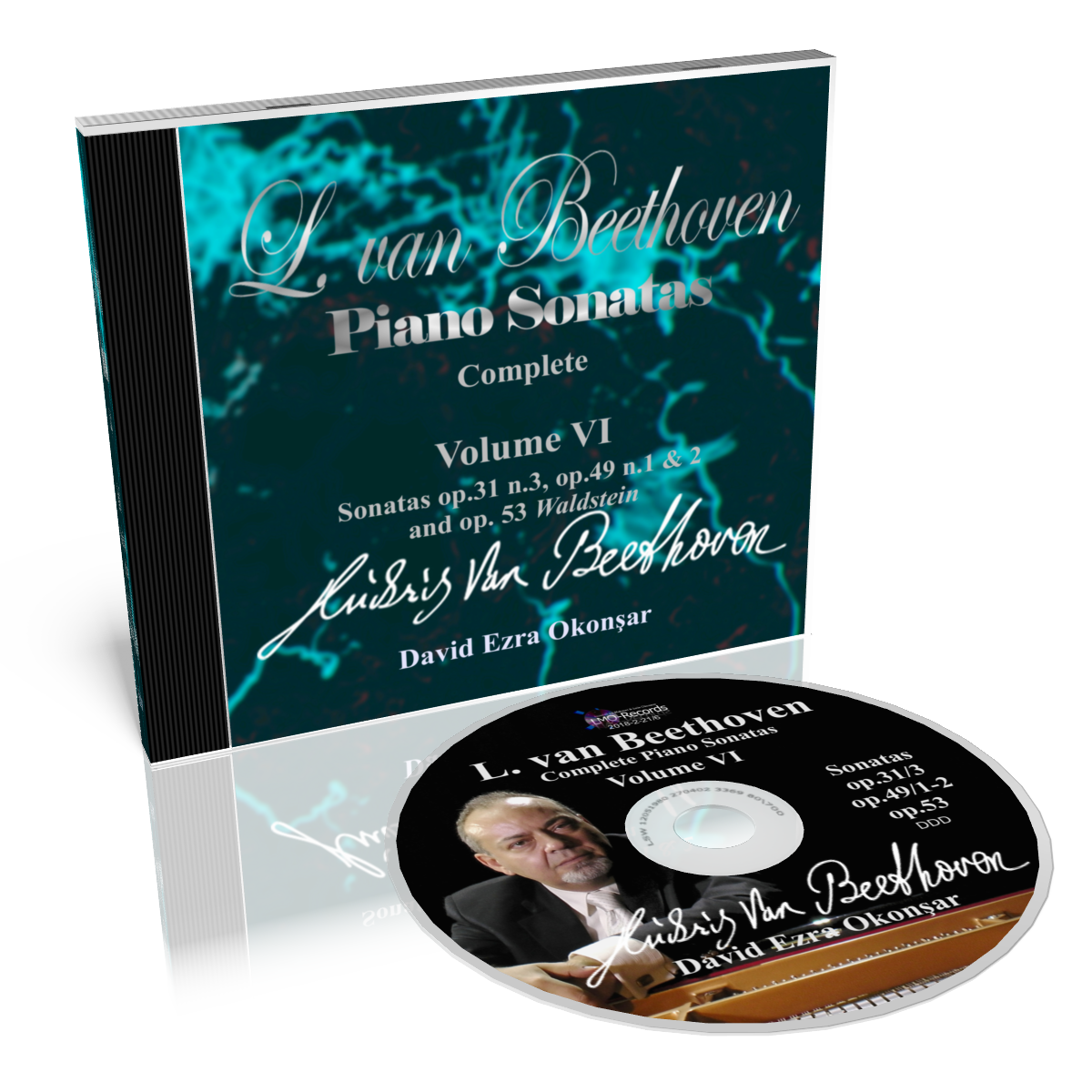
Piano Sonatas
Sonata N.18 in E-flat major op.31 n.3
Sonata N.19 in G minor op.49 n.1
Sonata N.20 in G major op.49 n.2
Sonata N.21 in C major op.53 "Waldstein"
Volume 6 of the series:
The Complete Piano Sonatas by Ludwig van Beethoven



|
The Sonatas N.18 E-Flat Major "The Hunt"; N.19 G-Minor
N.20 G-Major "Two Easy Sonatas" and N.21 C-Major "Waldstein" By
Beethoven
Sonata N.18 in E-flat Major op.31 n.3Last Sonata of the series opus 31, "La Chasse", was composed in 1802 and first published by Naegeli, Zürich in 1804 with the opus number 33. Later, when published by Cappi in Vienna in 1805, it has been included in the series opus 31. All three Sonatas opus 31 are dedicated to the Countess of Browne. After the tumultuous, "Tempest" (opus 31 n.2), this Sonata gets back to the spirit of the first number of the same opus (Sonata op.31 N.1 in G Major) and even to the joyful amiability of the Sonata "Pastorale" (op.28). Some commentators even thought of naming it (another) "Pastorale". Finally, another title stood with it: "Wachtelschlag-Sonate" ("[the Sonata of the] call of the quail"). Fortuitously, Beethoven seems to allude to the particular call of this bird with a typical melodic and rhythmical shape. Moreover, he makes it the theme of the first movement. It is heard again, but under some "disguise", during the Scherzo and the Finale as well. Called "another Pastorale" by Jörg Demus, this Sonata is undoubtedly, again, drawing from Beethoven's love for the nature. However, Demus pursues, "more a series of feelings [generated by it] than a [descriptive] painting of the nature". This description was used by Beethoven himself, later, for his Pastorale Symphony. To each of those "scenes" (movements) a descriptive subtitle may be appropriately added, if wanted. "Birds in the forest"; "Stampede at dawn"; "A rustic song"... On the other hand, "La Chasse", (The Hunt) is a well known title for this Sonata, specially in French speaking countries. Few other interesting points: this 18th. Sonata is the only one, in Beethoven's so-called "second-style", featuring the traditional four movements. There is no proper slow movement, but, instead, between the two outer fast movements are a Scherzo and a Menuet. This is very rare. Jörg Demus noted, the succession of the last three movements: Scherzo - Menuet - and the Finale (resembles to a Tarantella) makes it look like a "Suite". Three movements, the first, the second (Scherzo) and the last (Presto), have a clear Sonata-form by themselves. I. Allegro The Sonata does not start "straight" in the key or in the tempo. An ambiguous chord (5/6 on A-flat) and a motivic cell, both named "a question mark" by Bernstein, which are only the first part of the full theme, are exposed and repeated. This "question mark" like theme is followed by a series of chords moving chromatically at the bass and slowing down to a stop on the sixth-fourth chord of the tonic. Finally a real full harmonic cadenza affirms the key of E-flat Major, but immediately it runs to another exposition of the "question mark" one octave higher, with, again, the same slowing down of the beat and the same harmonic progression, but this time spread into a larger keyboard range. Finally, both the tempo and the harmony are set and the full theme is exposed on bar 18. Large intervals and, in the repetition, the first note being replaced by a trill indicates a clear reference to kind of bird song. The lyrical second theme keeps this light and slightly parodic aspect. The development takes on with the first theme encompassing several keys. An ornamental re-exposition brings the joyful and strong Coda. II. Scherzo: Allegretto vivace It is a large scale Scherzo, made in the purest Sonata form. Its tempo indication: Allegretto vivace calls for a lively and light touch. The beautiful right hand melody is obviously thought for the French horn section of an orchestra, while the staccato left hand, referring to pizzicato basses and cellos, is more of a kind of cavalcade. Nervously repeating 32nd and rolling 64th notes as well as sudden fortissimo chords preceded by slowing down diminuendos make this movement extremely flamboyant. III. Menuetto: Moderato e grazioso At that time Beethoven already abandoned the Menuet form. However, he will "look back to it" in this Sonata, and even make a kind of "remembrance of a Menuet", later, in the first movement of his Sonata in F Major opus 54. This is a shorter movement featuring a hunched up theme in a very narrow range, like a rustic romance. In a strong contrast, its Trio features large jumps of chords in a capricious appearance. Saint-Saens will use that theme of the trio in his Variations on a Theme by Beethoven. IV. Presto con fuoco Again a movement in the Sonata form, this fast dancing and jumping movement presents in many places fine and subtle metrical displacements. Right from the beginning the accompaniment figure of the left hand, seems to be displaced in regard to the melody at the right. This Finale is a brilliant, large scale Presto filled with harmonic, rhythmic and instrumental novelties. Sonatas N.19 in G Minor op.49 n.1 and N.20 in G Major op.49 n.2 These "easy sonatas" for the piano, as they are called by the composer, were probably composed, according to the sketchbooks, around 1797 and 1798 for teaching purposes. They were published much later, in 1805 in Vienna. The style is one of the very young Beethoven and they may be called "sonatinas". They follow the lines of Carl Philipp Emanuel Bach and Haydn. Each of them has only two movements. Sonata N.21 in C Major op.53 "Waldstein" This famous sonata is dedicated to Comte Ferdinand von Waldstein who gave support to the composer in Bonn. It was drafted in 1803 and finished in 1804. Beethoven introduced it to the publishers Breitkopf und Hartel, who rejected it, the Sonata finally get published in 1805 in Vienna. It was planned in three distinct movements with one Andante with variations in the middle. This was later dropped by the composer who published this Andante separately: Andante in F Major (WoO 57). Instead he composed an Introduction to the final Rondo for this Sonata. Being composed simultaneously with the first version of Fidelio, the Waldstein-Sonata follows, in its style, the last two numbers of opus 31. It displays perfectly the so-called second style of Beethoven, featuring extensive and audacious development sections with a very brilliant and virtuoso keyboard technique. Together with the name of the dedicatee, the Sonata is also known, specially in French speaking countries, under the title "Aurore" (dawn). The origins of this title is obscure, probably due to some other publisher. Several explications for this title was given, none very convincing. For example: "a dawn of an ideal then unknown in the music" (Claude Rostand). Anyhow, it is interesting to note that Beethoven from then on composes almost exclusively for the most skilled and accomplished performers. This evolution can be set in parallel with the changes and progresses made in the making of the instrument. The "piano-forte" has been greatly improved, in Vienna by Stein and Streicher, in France by Erard, in England by Broadwood. Many technical, (i.e. action-related) improvements took place and the sound possibilities expanded greatly. The last movement of this Sonata stands apart by the expansion of the Rondo form which makes its central core. The rondo-form, already expanded in many earlier Sonatas makes here not only the apex of the work, but also the summit of the genre, it reaches levels never attempted before. I. Allegro con brio The first movement reveals a large sonata-form. It is interesting to note that the two main themes are not presented one following the other but instead, the first one is exposed twice thus delaying the entrance of the second theme up to bar 35. Furthermore, the first theme itself does not appear as a theme but rather as a "collection of (first) themes" (Jörg Demus). The bright and virtuoso first movement shows many interesting harmonic progressions. In the beginning, a particular, non-classical, harmonic progression uses a bass line going down chromatically from C to G, to bring the first fermata at the dominant key (G). Then the first theme is re-exposed this time with alternating tremolo figures. An overly chromatic right hand motive is moving towards the mediant key of E Major, passing through E Minor. This key of E Major, in a context of C Major, produces an overly bright sound for the exposition of the second theme: "dolce e molto legato". It is almost a liturgical second theme, shining through the key of E Major, and in A Major during the re-exposition. The number of tonal regions visited in the development section with vast arpeggios is overwhelming. It may be interesting to note that in this section Beethoven visits almost all keys with flats. According to Jörg Demus, this has an effect of balancing the exposition and re-exposition sections which are moving in keys with sharps. II. Introduzione: Adagio molto - Rondo: Allegretto moderato, Prestissimo The short "introduction", only 28 bars, replaced the extended Andante Beethoven composed for this Sonata in the first place. This Adagio starts as if it was a vast slow movement. But its melodic momentum is exceedingly short. It starts again three times and when, finally it does get momentum, when its melody really expands, it is "stuck" at the apex and falls rapidly to a stop which will beautifully prepare the entrance of the Rondo theme. The last note G (with dominant harmonization) of the introduction will change colour and become the first note (with a tonic harmonization) of the Rondo. The pianissimo theme of the Rondo has a very particular swinging between C Major and Minor alternatively sounding E-natural and E-flat. This "interplay" of lighting produces a unique "claire-obscure" effect. Two large intermediary sections one in A Minor, the other C Minor and A-flat Major are all powerful and brilliant. A large "bridge" with evaporative arpeggios in many foreign keys will stop on the dominant chord of G and then jump to the short but even more brilliant Coda, Prestissimo. Note the shortening of the theme by the tempo acceleration and by metrics (2/2 instead of 2/4). The trill in Beethoven is a very particular subject. Originally the trill is an ornamentation and its origins are traced well before the emergence of the piano. From this Sonata, the trill will acquire its "Beethoven-ian" significance: a particular "sound-effect". According to Claude Helffer, the original idea of a trill as a "vibrating sound" in Beethoven's piano works, emerges here for the first time, clearly and persistently. It will appear on almost all works by Beethoven for the piano composed from then on and it may be elongated to entire pages as a particular "timbre" (Andre Boucourechliev). For more insights into those Sonatas please watch the video "About.." below |
||||
|
|
||||
|



